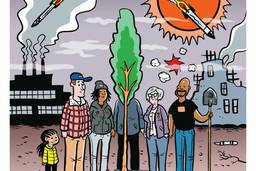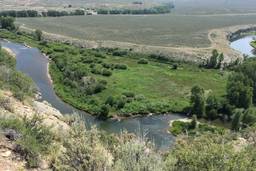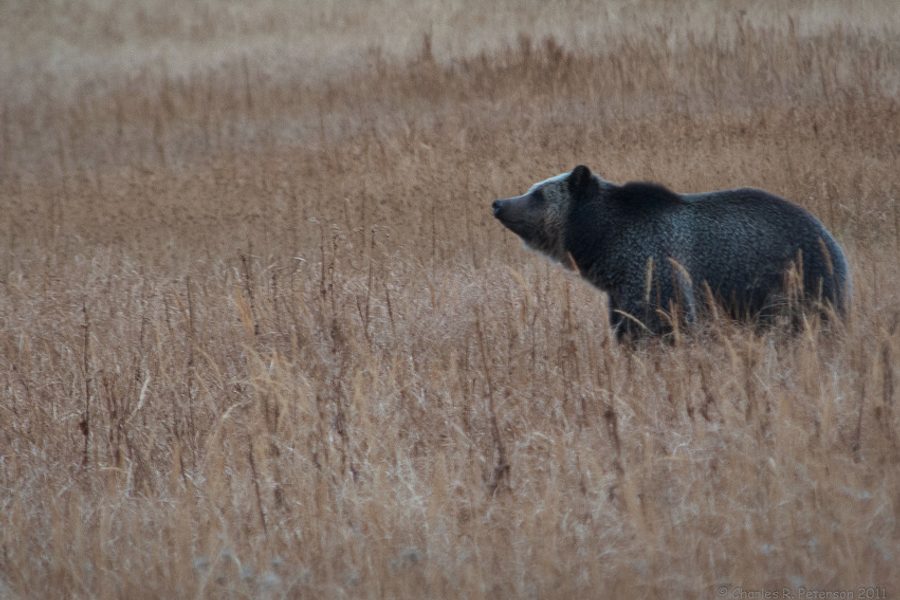
I recently went hiking in Yellowstone National Park. It is a place bursting with lakes and forests and canyons so large they threaten to swallow you up — at times, I found myself wishing they would.
Perhaps no single creature better encapsulates this feeling evoked by the American West — awesome and dangerous, humbling and threatening — than the grizzly bear. In Grizzly West: A Failed Attempt to Reintroduce Grizzly Bears in the Mountain West (released earlier this month), environmental historian Michael J. Dax explores the rising tensions between the conservative Old West and environmentalist New West, and documents how grizzlies got caught in the crossfire.
Dax’s subject is, as the subtitle suggests, a failed attempt throughout the late 1990s and early 2000s to reintroduce grizzly bears into the Selway-Bitteroot Wilderness along the Idaho-Montana border. This wilderness, coupled with the adjacent Frank Church-River of No Return Wilderness, makes up the largest roadless area in the Lower 48.
Countless books and documentaries exist to help you fall in love with the bear, to showcase their intelligence, strong mother-cub bonds and the transformative roles they play within their ecosystems. Dax, however, explores the bear more as symbol than as organism. He traces the West’s changing character and the broader development of endangered species politics, giving us the comprehensive background we need to understand the bear’s fate, and what the Bitterroot defeat can teach us for the future.
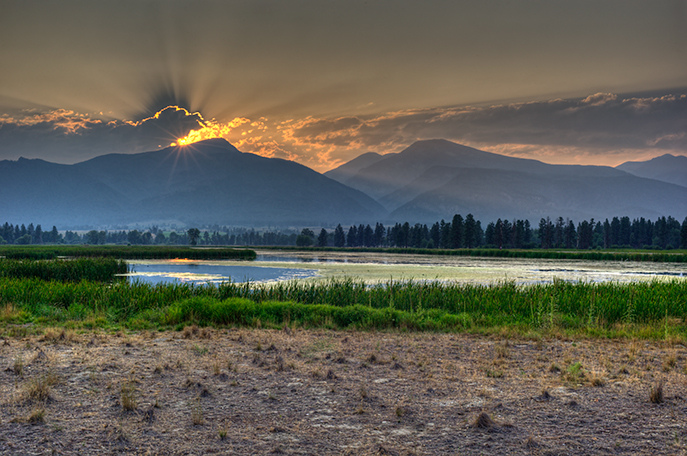
Sunset over the Bitterroot Mountains — not a grizzly to be seen. (Diana Robinson / Flickr)
The Wise and the Horrible
Of the planet’s eight bear species, the three found in North America (outside of captivity) are the black, the polar and the brown. (Don’t let the names fool you: Black bears can be a range of colors, and the best way to distinguish brown bears is by their shoulder hump and larger size.) “Grizzly” technically refers to one particular subspecies of brown bear, identified by its grey-tipped (grizzled) fur, but it is often used as an umbrella term for all North American brown bears.
The black bear’s ancestors reached our continent 3.5 million years ago. The brown arrived an estimated 50,000 to 70,000 years ago — still long before humans. Many North American First Nations, like other pre-agrarian (and moderately agrarian) societies throughout the world, have felt a special connection to the bear, who feature prominently in myths and ceremonies.
According to Nez Perce legend, what we call the Lolo Trail through the Bitterroot Mountains “was established when a grizzly bear guided a lost boy through those mountains,” Dax writes. Unfortunately, European settlers had long lost this respect for the nonhuman world. In 1804, when the Lewis and Clark expedition became the first group of Euro-Americans to see a grizzly, they also immediately became the first to shoot at one.
In 1815 naturalist George Ord, a man who had never encountered a grizzly outside of Lewis and Clark’s reports, gave the species its “scientific” name: Ursus horribilis—a fateful PR decision with 200 years of consequences. While the grizzly was later recognized as a subspecies of the brown bear, Ursus arctos, the name stuck, and even today the bear is officially classified as U. arctos horribilis.
Meanwhile, Homo sapiens sapiens put “wise” in its own name twice.
European colonization meant the same thing for the grizzly as it did for the buffalo and the wolf, not to mention indigenous humans: wholesale slaughter. The last Texan grizzly was killed in 1890, and since 1922 the only wild grizzly left in California has been on the state’s flag. Over the decades hunting, trapping and habitat loss knocked out the grizzly from Utah, Oregon, New Mexico, Arizona, Colorado and the whole country of Mexico.
There may have been as many as 100,000 grizzlies south of Canada pre-settlement, but by the mid-1900s less than one percent of this number remained, and the species covered less than two percent of its original range.
These killings were motivated in part by a fear of attacks and justified by economic concerns such as protecting livestock, clearing space for ranching, logging and farming and, to a lesser extent, selling the hides. Hunters sought glory in the mountains, and the U.S. Biological Survey poisoned bears and wolves in the name of animal agriculture.
Public support for extermination was stoked by highly emotional rhetoric against these scavenging flesh-eaters, rhetoric still in use today. Few have ever seemed to point out that grizzlies are opportunistic omnivores and excellent foragers of fruits, nuts and roots — in some regions consuming up to an 80 percent plant-based diet. (That’s more than today’s average American can say, given our addiction to meat and diary.)
What I found most fascinating is the white man’s need for what Dax calls “ideological dominance.” The grizzly’s size, strength and adaptability threatened the moral underpinnings of a civilizing project built on white supremacy and Christian exceptionalism, and settlers had to prove themselves king of the forest.
To properly understand this dogma, we must look to turn-of-the-20th-century wilderness advocate John Muir. In this striking passage from A Thousand-Mile Walk to the Gulf, the feisty backpacker both summarizes and skewers the prevailing ideology:
The world, we are told, was made especially for man — a presumption not supported by all the facts. A numerous class of men are painfully astonished whenever they find anything, living or dead, in all God’s universe, which they cannot eat or render in some way what they call useful to themselves. …
But if we should ask these profound expositors of God’s intentions, How about those man-eating animals — lions, tigers, alligators — which smack their lips over raw man? … Doubtless man was intended for food and drink for all these? Oh, no! Not at all! These are unresolvable difficulties connected with Eden’s apple and the Devil.
Muir had “precious little sympathy for the selfish propriety of civilized man, and if a war of races should occur between the wild beasts and Lord Man, I would be tempted to sympathize with the bears.”
Conserve or Protect?
Dax contrasts Muir’s aim of preserving the wild with “wise use” conservationism — an anthropocentric ethos that has governed natural resource policy since Theodore Roosevelt’s time. It was clear that the extractive ranching, logging, mining and farming enterprises that dominated the Old West economy would quickly exhaust themselves without recognizing at least some environmental limits. They accepted the need for moderation. But, as Muir had so forcefully lamented, the existence of grizzlies and other large predators had no place within this economically utilitarian mindset.
The legacy of Muir and other like-minded thinkers (most famously Henry David Thoreau) did not die out completely, and the 1960s and 1970s saw the rapid rise of the environmental movement. As Dax writes, environmentalists saw “intangible, spiritual benefits” in a thriving nonhuman world, and nowhere was this felt more strongly than in the American West. Juxtaposed against the industrialized east coast, the West’s mountains and forests were practically an Eden. The region saw an influx of new residents representing a “New West,” and the tourism and service sectors began to rival, then surpass the extractive economy.
Dax attributes the early support of environmentalism to economic growth. More disposable income and the spread of roads and automobiles allowed natural parks to become more accessible. This strikes me as a depressing irony: If overconsumption, habitat-fragmenting highways and oil-gulping, carbon-spewing cars are foundational to the environmental movement, I wish us all the best of luck.
Internal contradictions aside, the greens had some stunning early successes. For the grizzly’s purposes, the most relevant was the 1973 Endangered Species Act (ESA), which passed the Senate 92-0 and the House 390-12 and was heartily supported by Richard Nixon. Habitat loss, hunting and other human interference pushed grizzly bears onto the ESA’s list of threatened species in 1975, meaning that humans could only shoot grizzlies in self-defense, and that logging, mining and ranching must respect grizzly habitat.
While the ESA had been universally popular in theory, environmentalists lost a lot of momentum once people saw how costly it could be, and the act almost immediately raised hackles. In 1973, a previously undiscovered 3-inch long fish, the snail darter, was found in the impact zone of Tennessee’s under-construction Tellico Dam — a project that had begun in 1966. In 1975 the snail darter was listed as endangered, and the next year environmentalists sued to stop the dam. The Supreme Court ruled in the fish’s favor, but Congress still wanted the damn dam built — and through some legislative acrobatics, they got their way. Construction finished in 1979, and many thought the darter doomed. Luckily, the plucky little species was later detected in nearby rivers, and lived to swim another day.
The next big kerfuffle was over the spotted owl, imperiled by the timber industry in the Pacific Northwest. What in theory is a strictly scientific question — whether the owl should be protected under the ESA — became a political one as loggers fought environmentalists to keep the owls off the list. The heated controversy lasted over a decade, but in 1990 the owl was classified as threatened.
Perhaps the most exciting ESA victory came in January 1995, with the reintroduction of the gray wolf into Yellowstone National Park. But this was a long and hard-fought battle, expending much of the political capital that could have saved the grizzlies in Bitterroot. Compared to bears, wolves are less dangerous to humans but more dangerous to livestock, and many Old West ranchers weren’t ready to undo the thorough job their ancestors had done in exterminating the wolves.
The environmental movement no longer had the mandate it once had, Dax explains. The economic boom had subsided in the late 1970s, and suddenly saving endangered species seemed less urgent. Some environmentalists responded by becoming more conciliatory, but the frustration of the Reagan years drove others further left. The Old West, once progressive, had begun to rebel against what they saw as intrusive federal oversight and land management. And while the New West saw wolf reintroduction as a crowning success, the Old West was far from surrender.
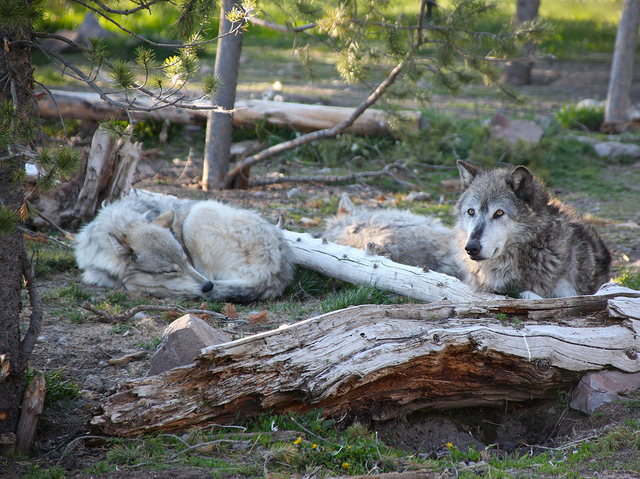
Gray wolves in Yellowstone once more. (Steve Jurvetson / Flickr)
Grizzly Democracy
Bears, like wolves, have seen a dramatic shift in public perception over the past century. These playful and curious predators, in part through ambassadors like Smokey and Yogi, have gone from mindless murderers to lovable symbols of the wild. The polar bear, the most carnivorous Ursos, has become the poster child of climate change and Coca-Cola.
Nationally, majorities supported grizzly reintroduction into the Selway-Bitterroot Wilderness, just as they had supported wolf reintroduction into Yellowstone. But locally, opposition was louder and more widespread.
In the case of wolves, the environmental nonprofit Defenders of Wildlife counteracted the opposition with aggressive education campaigns, addressing popular misconceptions and seeking to fundamentally recast humanity’s relation with Old Yeller’s cousin. The media outreach blitz overwhelmed conservative opponents, but left them alienated and angry.
Hoping to limit any bitterness over Bitterroot, some environmental groups (in particular Defenders of Wildlife and the National Wildlife Federation) sought to implement a more collaborative approach to grizzly reintroduction. Ranchers were the main enemies of wolves, but with bears they knew the main opposition would come from loggers. In 1993 they reached out to the Resource Organization on Timber Supply (ROOTS) in search of compromise. The timber industry, for their part, had conceded that reintroduction was likely, and was eager to have at least some say in the matter.
Compromise they did. The new Bitterroot grizzly population would be classified as “experimental” and “nonessential,” thus limiting restrictions on the timber industry, and long-term grizzly management would be controlled by a citizens’ committee — a group mostly appointed by the Idaho and Montana governors. Environmentalists would still get their grizzlies, and the ROOTS coalition’s plan was assessed and endorsed by the federal government much more quickly than wolf reintroduction had been. Unfortunately, neither side escaped the firestorm they’d been hoping to avoid.
As the U.S. Fish and Wildlife Service’s grizzly expert Chris Servheen put it: “Nobody has no opinion about grizzly bears.” For many in the Old West, according to Dax, the actual threat posed by the grizzly was of little consequence. This was a region sick of the federal government telling them what they could do with their property, sick of New Westerners who’d never worked the land telling them how to live their lives.
After the wolf, they saw grizzlies as insult added to injury. The Montana Stockgrowers Association derided “the government’s lust for foreign predators” (the bears, like the wolves, were to be imported from Canada), and Idaho representative Helen Chenoweth colorfully proclaimed, “The only practical purpose the grizzlies would serve is if they ate gray wolves.”
Even Idaho governor Dirk Kempthorne, at first undecided, eventually turned against the bear: “Whenever there’s an encounter between a human and a grizzly, the human does not fare well.” After centuries of hunting and habitat destruction, I suspect the bears would beg to differ.
One Old West landowner got to the heart of this antagonism: “In all honesty, I don’t think this is about grizzly bears. This is about power.”
The political controversy would delay federal approval through the twilight of the Clinton years, and while the ROOTS plan was officially adopted by the Fish and Wildlife Service in 2000, the Bush administration never bothered to fund it. Dax lays the grizzly’s share of the blame on the intransigent right, but he also seems frustrated with those on the left, such as the Alliance for the Wild Rockies (AWR) and the Sierra Club, who rejected the ROOTS plan’s compromises.
In the AWR’s “conservation biology alternative” (CBA) plan, a larger region of the wilderness would be more stringently protected from timber. Dax describes the CBA as “biologically pure but politically inept.”
The CBA objected most stridently to the citizens’ committee, which the AWR’s Mike Bader compared to letting “the fox manage the chickens.” Instead, the plan called for more federal control and scientific input. Bader maintains to this day he is glad the ROOTS plan failed. If bears are to be reintroduced — which he hopes they are — he wants it done right.
I do not quite know how to feel about this debate. I don’t share Dax’s conviction that pragmatism and compromise were the necessary approach to grizzly reintroduction — the ROOTS plan failed despite these, and some things are surely worth fighting for. But if the CBA was truly politically unfeasible, wasn’t the ROOTS plan at least worth a try?
Dax argues that environmentalists’ reliance on courts and federal action backfired by firing up conservatives, who — understandably, I think — saw this as elitist and undemocratic. From Thoreau to Earth First!, many radical greens have shared a healthy distrust of the U.S. government, and I wonder whether calling for technocratic control over the citizens’ committee was a mistake.
It must be said that a committee of 12 governor-appointed members, two federal appointments, and one Nez Perce representative isn’t exactly direct, grassroots democracy — and states’ rights in this country have too often been the right to oppress.
But it’s significant that locals cared so deeply, regardless of their stance. While extractive industries’ political sway had kept conservative governors in office, local opinions on grizzly reintroduction swung wildly back and forth throughout the 1990s. Perhaps a truly open citizens’ council could see through the moneyed interests and inflammatory language and craft a meaningful discussion.
But then again, where is the voice of the bear in all this, and the ecosystems that grizzlies help maintain? Aren’t they, in reality, the most affected?
As a hiker, Californian and wildlife lover, I suppose I am ideologically part of the New West. Dax, who now works with Defenders of Wildife, seems to sympathize with the New West, too. But he is cognizant of its flaws, especially its arrogance. Grizzly West should inspire advocates to reconsider our interactions with local working populations.
Towards a New New West
One New Westerner, at a public discussion on reintroduction, said, “To live with the grizzly is an exercise in humility — an admission that we do not and should not control everything.” This feels right to me, but it’s also incomplete.
For the Old West, Dax notes, masculinity means conquering nature. For the New, it means experiencing nature’s perils. With the Endangered Species Act under attack in Congress and a new grizzly reintroduction debate underway in Washington’s North Cascades, I’d rather leave testosterone out of it.
The grizzly is neither an enemy nor a means to our spiritual development, neither something to conquer nor something to experience, but simply an equal. “Nature’s object in making animals and plants,” wrote Muir, “might possibly be first of all the happiness of each one of them, not the creation of all for the happiness of one.”
The night before I left Yellowstone, I found myself in a small crowd squinting at a distant hillside. A grizzly was eating an elk carcass, while a wolf lay down in wait just a few meters away. When the bear was sated, she simply rambled off, leaving the carcass behind. The coast now clear, the wolf jaunted over to dig in.
The crowd urged the bear to react: “Fight!” at least two people cried, craving some carnal satisfaction in sharp teeth and bloody jaws. The bear, thank goodness, paid us no mind, leaving the wolf free to keep tugging at the meat. According to a park ranger, the wolf would bring some back to feed his pups. And the grizzly, with the wolf gone, would return. And so it would continue, two apex predators accepting the other’s presence, engaged in an ongoing dance of wary respect.
Dayton Martindale is a freelance writer and former associate editor at In These Times. His work has also appeared in Boston Review, Earth Island Journal, Harbinger and The Next System Project. Follow him on Twitter: @DaytonRMartind.



